Sequencing your microbiome is a great way to find out more about the particular microbes living inside of you. You can read more about what microbiome sequencing is and why it is done in Part 1 to this article.
Analyzing a poop sample can provide a unique one-time snapshot into the bacterial composition of the gut at a particular moment in time. Taking and analyzing multiple samples over time lets you see how lifestyle changes, such as taking antibiotics, increasing exercise, losing weight, stopping/starting drinking alcohol, reducing stress, or adding fiber and fermented food to your diet affect the health of microbes in your gut.
Our family has chosen to become microbial explorers by having our gut microbiomes sequenced by uBiome1. The process involved sending samples of each of our feces to uBiome’s lab for sequencing and analysis. uBiome kindly donated four gut sampling kits to us (valued at $89 each) – one for each member of our family – so that we could share our experience with our readers. They also offer kits to permit testing of the mouth, nose, genitals, and skin, but we have not tried those yet.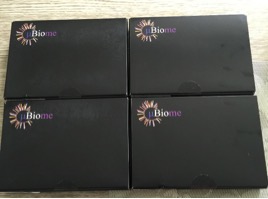
uBiome, along with American Gut Project, is an organization that specializes in sequencing of human microbiomes to permit interested volunteers to find out more about the microbiomes found in and on their bodies. According to the company, “uBiome is a microbiome sequencing service that provides information and tools for you to explore the populations of bacteria that live on and inside your body. Based on research from the NIH Human Microbiome Project, we’ve perfected the technology to perform large-scale microbiome studies.”
The gut microbiome sequencing we undertook has given each of us information about which microbes were living in our guts at the time of sampling, as well as summarizing known information about some of the bacteria. We can now compare our results with each other as well as with uBiome’s other customers’ data that is summarized on the site. We can narrow down the comparisons by sex, lifestyle factors such as diet, alcohol consumption and weight to find out how our microbiomes contrast with others in the various groups.
The results, while interesting, do not provide concrete suggestions about particular lifestyle changes that we might make to improve our microbiome health. Nor do the results diagnose disease. However, we were happy to learn that each of our microbiomes were pretty diverse and primarily made up of helpful bacteria. Had our results shown an unhealthy mix of microbes, that would have been useful information and would have spurred us to take steps to improve our gut health. Finding out that our gut microbes were already generally healthy affirms that the health-promoting lifestyle that we have been following seems to be working at a microbial level.
As the science evolves, and medicine learns more about exactly what constitutes a healthy microbiome for individual people, the sequencing results will begin to provide information that could be used to make specific, personalized recommendations to improve the mix of one’s gut flora for overall health benefits. We were happy to contribute our information to uBiome’s growing database – giving this emerging field of medical science three more samples to analyze and learn from.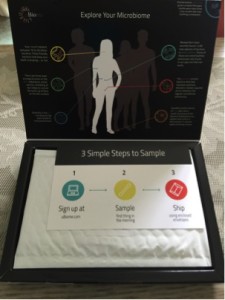
I was curious to find out what similarities and differences exist between the three of us, given the fact that we live together and have similar diets. One of our children has not yet had his sample analyzed as he had the stomach flu when we sent in the other samples and we suspected that would yield skewed results from his normal state. We will submit a healthy sample from him later and will update the results when we get them.
Is it Hard to Take a Gut Sample?
Obtaining a sample of each of our feces was much easier and less gag-worthy than I expected. Because we chose to have our gut microbiomes evaluated, we had to provide poo samples for analysis. I felt a little bit nervous – squeamish actually – about doing this. Happily, to get a sample you only need to swab toilet paper used to wipe yourself after taking a bowel movement with the provided brush and swish it around in the enclosed test tube. After that, we sent the samples back to uBiome and waited for our results.
Instructions
The instructions that come with the kit are a little light on detail, although they give a sense for how easy the sampling actually is.
To find out more, I went to uBiome’s site (http://ubiome.com/pages/faq#collect). Here is what they say about collecting a poo sample for analysis:
- START
Sampling takes less than 3 min per site. Faster than a dividing bacteria! We recommend you leave your kit on your bathroom counter so it’s ready first thing in the morning. Sample first thing in the morning, before you brush your teeth or eat breakfast.
- SAMPLE
Open the tube you want to sample and the follow the site-specific instructions below:
GUT SAMPLE:
Swab your used toilet paper to collect a tiny amount of poop. Note – this probably way less than you think you need – just enough to change the color of the swab.
- STIR AND SHAKE
Put the used swab into the vial and stir it for 1 minute to transfer the bacteria. Discard the swab in the trash. Close the tube tightly and shake vigorously for 1 minute.
- SEND
All of kits include a secure mailer, so that you can send your samples right back to us. US kits come with prepaid postage. Just drop the envelope in the mail.
Registering
Before sending in your sample, you need to register your kit at uBiome’s site. Doing this will link the ID number on your sample kit to you and your results.
As part of the process, you will be prompted to complete a very detailed survey about your current health, diet, alcohol consumption, antibiotic history and other lifestyle factors. This gives uBiome valuable information, which will then be linked to your sample and microbial analysis. You can decide whether or not to give them permission to anonymize and aggregate your data with that of other samples collected by uBiome.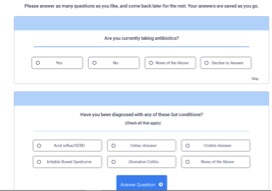
Your information, together with all of the comparable data which has been gathered from others who have had their microbiomes analyzed by uBiome, provides a sample set for studying how various factors in a person’s life might affect the composition and health of their individual microbiome.
Although you do not need to complete the questionnaire to receive your gut sequencing results, by sharing information about yourself you will benefit research being done into the relationship between the human microbiome and health.
Because of all of the detailed, health and lifestyle information that it is collecting, it is important that uBiome protects your data and your privacy. uBiome assures its customers that it provides multiple layers of data encryption to the data you provide, in addition to high level computer security. However, as we hear on the news on a regular basis, data breaches can occur at major companies. Fortunately, uBiome is probably not very high on the list of attractive targets for computer hackers. However, if you are particularly concerned about medical privacy, you should give it some thoughtful consideration before going forward with the test. We felt that for us, the benefits of obtaining the information outweighed the risks of our gut analysis data getting out there in cyberspace.
Results
A few weeks after mailing in our samples, we each received an email from uBiome letting us know that our microbiomes had been sequenced. It invited us to log in to view the results.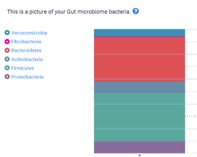
When I first looked at the Dashboard, it looked like the results were very light on details, however after delving in further, I realized that there was a great deal of information provided once I started clicking on links that allowed me to drill deeper on areas I was interested in.
Bacterial Inhabitants
The top of the page provided the top six Phyla of bacteria found in my sample and provided percentages of each one. I could then compare my results to all other results or to specific subsets of people. As bacterial diversity is associated with a healthy microbiome, I was pleased to find out that my sample was more diverse than 93% of other samples in uBiome’s database. This did not really surprise me, given that I drink kefir, a high-probiotic fermented beverage, regularly. However, I have taken many antibiotics in my lifetime so it also came as a relief.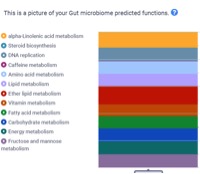
I was also happy that my Firmicutes were lower than average and Bacteroidetes higher than average as that ratio of these two bacteria is associated with a microbiome promoting thinness, as opposed to obesity.
Clicking on the See All Bacteria link brought up a pop up window that allowed me to see a list of all bacterial inhabitants found and their relative percentages, listed at the phylum, class, order, family or genus level. For the majority of these, I was able to click on the name of the bacteria listed to find a summary of what was known about these microbes and their correlation with health or disease.
At the Phylum level, my sample contained higher than average levels of Verrucomicrobia, which is also found in high levels in hibernating squirrels. Go figure. Perhaps this explains my recent low energy levels.
At the Family level, I had more than 4X the average level of Clostridiaceae and it was my 3rd most numerous microbe. uBiome says about these microbes, “Clostridiaceae are commonly found not only as part of our own gut and skin microbiomes but as part of many other mammals as well. Infants sharing their home with cats and dogs reportedly have enriched representation of Clostridiaceae in their microbiomes, and other stories have reported that such children demonstrate lower risk for allergies, asthma, and other autoimmune disorders.” I have a cat and no known auto-immune issues so that seems believable.
Unfortunately, the top two Family-level inhabitants found in my microbiome at much higher levels than average had no links at all for me to click on and find out more. I’ll keep checking back as they add more details all of the time and I’m curious to learn more about these microbes.
Because of the sheer number of microbes identified I could spend hours going through them all and clicking on them to find out more. Fortunately, I did not find many harmful microbes identified in my sample and I noted that many of those that I had in good numbers were associated with a healthy gut and disease fighting abilities.
There was a surprising amount of difference found in the results between me, my husband and particularly our teenager.
Although he is quite slim, our growing son is at an age where he eats everything in sight and is craving calories, sugar, and carbohydrates. The analysis of his microbiome revealed the presence, in significant numbers, of microbes that thrive on high fat, high carb diets and are also associated with obesity – meaning those microbes are efficient at harvesting the energy found in food where it can be converted by the body to fat (and perhaps also be used to fuel growth?). I suspect that the presence of these microbes in high numbers are more a function of him being in a growth spurt at this point in his development rather than being predictive of him becoming overweight later on. I would expect his microbiome to evolve as he becomes a full-size adult. We will do a repeat test on him in a few years to see what changes.
Bacterial Functions
The dashboard also provides a listing of the primary functions performed by the microbes found in high numbers in my sample. I was able to see the predicted functions for my primary microbes. I could compare my results with the predicted functions found in other people who had been tested.
I found this fascinating, although the tool does not yet provide any explanations that allowed me to interpret this data in more useful ways. For example, I found out that I have a higher than average ether lipid metabolism, but I do not know if that is a bad thing or a good thing. To more fully understand the information provided, I would need to consult with a doctor with an expertise in microbiology or perhaps an endocrinologist.
Most surprisingly, my predicted caffeine metabolism was substantially lower than most other people’s. Because I am an avid and enthusiastic two-cup-a-day coffee drinker, I found it strange that my caffeine metabolizing microbes are in lower-than-average numbers. Conversely, both my son, who does not drink caffeinated beverages and my husband, who is a two cup a day kind of guy, each had a predicted caffeine metabolism of > 2X the average. At first glance this seems like a counterintuitive result, but again I’m sure an expert could explain this so it makes sense.
As this area of research evolves, this information will become much more useful in terms of being able to apply these results in personalized medicine to improve one’s own health.
In Conclusion
At this point, a microbial analysis cannot be used as a diagnostic tool. The science is just too new. However, there are many reasons why having this test done is still a useful thing to do for the health-conscious or scientifically minded person. And the information provided by uBiome’s interactive tools will be continually updated as knowledge evolves, becoming more useful over time, so you can keep checking back over time for updates to learn more.
If you are passionate about the human gut microbiome like me, or merely curious to know more about the inner workings of your body, having a microbiome sequencing analysis done will be a fascinating exercise, giving you a window into the microbial inhabitants that provide us with so many benefits.
If your goal is to improve your gut health, taking a series of these tests over time in conjunction with gut-health-promoting lifestyle changes will enable you to track your progress. You will see how the mix of microbes change and can work to increase the numbers of the good guys at the expense of the bad ones.
If you suspect that you are having health problems triggered by an unhealthy mix of gut microbes, having your microbiome sequenced can provide another data point to confirm your suspicions and repeated testing can show if the situation is improving.
By contributing your testing data, you are helping science to expand in human microbiology. As more and more medical professionals are becoming convinced that the microbiome is a vital part of the human immune system, intricately linked to many different components of our health, you are performing an important service by becoming a part of the ongoing research.
And by having your microbiome sequenced, you are, in fact, a true medical pioneer.
- Disclosure: My husband and I are very small investors in uBiome, and these tests were provided to us at no charge [↩]





I was hoping to see substantial benefits from having kefir every day. I must say I feel better since having it for the last 6 weeks.